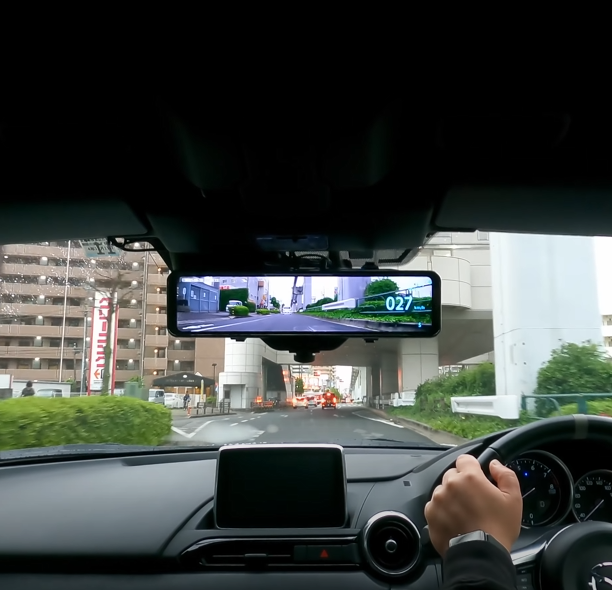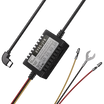Winter bedeutet, es sich zu Hause gemütlich zu machen und heißen Kaffee zu genießen. Wer liebt das nicht?
Früher oder später musst du diesen Komfort hinter dir lassen und hast keine andere Wahl, als dem Winterwahnsinn zu trotzen. Die winterlichen Straßenverhältnisse bringen eine Menge Herausforderungen mit sich - von eingeschränkter Sicht bis hin zu rutschigem Untergrund, der jede Fahrt zu einer potenziellen Gefahr macht.
Du kannst dein Auto zwar mit Winterreifen und Frostschutzmittel auf den Winter vorbereiten, aber absolute Sicherheit auf eisglatten Straßen zu gewährleisten, ist fast unmöglich.
Eine Dashcam wird zur absoluten Notwendigkeit, wenn die Fahrzeuge überall ins Schleudern geraten und das für alle Beteiligten unsicher ist.
Man könnte sich fragen, welchen Unterschied eine Dashcam in solchen Situationen machen würde - schließlich kann eine Dashcam nicht verhindern, dass ein Bus auf ein Fahrzeug zu schleudert.
Das stimmt zwar, aber mit einer Dashcam kannst du einen Videobeweis aufzeichnen, um zu beweisen, was genau an diesem Tag passiert ist.
Laut der Forbes-Statistik20 % der Versicherungsansprüche sind betrügerisch und Versicherungsbetrug ist ein Bundesverbrechen, das von der Bundespolizei im Rahmen des Violent Crime Control and Law Enforcement Act von 1994 untersucht wird.
Außerdem trägt das Winterwetter dazu bei 562.182 Autounfälle jedes Jahr allein in den USA. Das unterstreicht die Notwendigkeit von Vorsicht und Sicherheit, besonders im Winter.
Bleib dran, denn in diesem Leitfaden schauen wir uns an, wie eine Dashcam bei harten Winterbedingungen ein Lebensretter sein kann, und besprechen ihre Vorteile, die wichtigsten Funktionen und die besten Tipps, um ihre Funktionalität zu gewährleisten. Lass uns eintauchen.
Bereite dich vor, bevor du losfährst
Es ist wichtig, dass du auf Reisen im Winter vorbereitet bist, egal ob du einen Roadtrip im Winter machst oder Verwandte besuchst.
Die Bedeutung der Vorbereitung
Der Schlüssel zur Verkehrssicherheit ist die Vorbereitung. Überprüfe die Reifen, Bremsen und den Kraftstoff deines Autos. Halte wichtige Dinge wie Essen, Trinken und Decken bereit, falls du stecken bleibst.
Unvorhersehbares englisches Wetter
Das unberechenbare englische Wetter, vor allem im Herbst und Winter, kann plötzliche Veränderungen wie Schnee, Eis oder starken Regen mit sich bringen, die das Autofahren riskant machen können. Daher ist es wichtig, vorbereitet zu sein.
Die Risiken des Fahrens im Winter verstehen
Das Wetter stellt ein ernsthaftes Risiko für das Fahren im Winter dar, denn 13% aller Autounfälle in den USA auf vereister Fahrbahn und 16% auf schneebedeckten oder matschigen Straßen. Um diese Gefahren zu vermeiden, ist es wichtig, sie zu verstehen.
Hier sind einige der wichtigsten Risiken beim Fahren im Winter:
1. Verminderte Sichtbarkeit
Schneestürme, Nebel und eingeschränkte Tageslichtstunden können die Sicht auf andere Autos und die Umgebung erschweren.
2. Schlüpfrige Straßen
Bei Eis und Nässe ist die Gefahr größer, ins Rutschen zu kommen und die Kontrolle über dein Auto zu verlieren.
3. Unvorhersehbares Wetter
Plötzliche Wetterumschwünge, wie Schneegestöber oder Glatteis, können Autofahrer überraschen und zu gefährlichen Situationen führen.
4. Zunehmende Verkehrsunfälle
Die Daten zeigen, dass die Kombination der oben genannten Faktoren zu mehr Unfällen im Winter führt.
Tipps zum Fahren im Winter für deine Reiseplanung
Autofahren im Winter kann eine Herausforderung sein, aber die richtige Planung und Sicherheitsmaßnahmen können deine Fahrten sicherer machen. Hier sind einige hilfreiche Tipps für die Planung deiner Reise:
Plane deine Route
Du kannst Google Maps für die Navigation verwenden, aber du solltest auch eine physische Straßenkarte für lange Fahrten mitnehmen.
Überprüfe dein Fahrzeug
Bevor du dich auf den Weg machst, solltest du sicherstellen, dass alle Fahrzeugteile in gutem Zustand sind. Überprüfe Öl, Reifendruck und Windschutzscheibenflüssigkeit, um sicherzustellen, dass alles in gutem Zustand ist.
Prüfe die Wettervorhersage
Halte dich über die Wetterbedingungen auf dem Laufenden. Die Investition in Winterreifen kann deine Sicherheit auf glatten Straßen erheblich verbessern.
Dash Cam installieren
Installiere eine Dashcam, um alle Vorfälle aufzuzeichnen und im Falle eines Unfalls eindeutige Beweise zu haben.
Packe Snacks und Wasser ein
Halte dich mit Snacks und Wasser hydriert und energiegeladen, besonders bei langen Fahrten.
Teilt die Verantwortung für das Fahren
Wenn ihr mehrere Fahrer habt, solltet ihr euch beim Fahren abwechseln, um Müdigkeit vorzubeugen und konzentriert zu bleiben.
Vorteile der Verwendung einer Dashcam im Winter
1. Unfalldokumentation
Dashcams liefern bei Kollisionen wichtige Beweise, vor allem bei Glatteis oder Nebel.
2. Verbesserte Sichtbarkeit
Nachtsicht- und HD-Dashcams erfassen wichtige Details bei schlechter Sicht.
3. Warnungen in Echtzeit
Funktionen wie Geschwindigkeitswarnungen und Aufprallwarnungen fördern die Vorsicht auf glatten Straßen.
4. Versicherungsansprüche
Dash Cams vereinfachen die Schadensregulierung bei Winterunfällen durch schnelle, präzise Beweise.
Eigenschaften, auf die du bei Dash Cams für das Fahren im Winter achten solltest
Im Folgenden findest du die Funktionen, auf die du beim Kauf einer Dashcam achten solltest;
Low-Light oder Nachtsicht: Sorge für klare Aufnahmen in dunklen Wintertagen und -nächten, damit du im Falle eines Vorfalls sehen kannst, was passiert ist.
Breiter Dynamikbereich (WDR): Diese Funktion gleicht helle und dunkle Bereiche aus, was besonders bei Schneestürmen oder schlechten Sichtverhältnissen nützlich ist.
Schleifenaufzeichnung und große Speicherkapazität: Diese Funktionen gewährleisten eine kontinuierliche Aufzeichnung während langer Winterfahrten, damit du keine wichtigen Momente verpasst.
Langlebigkeit und Wetterbeständigkeit: Halte Ausschau nach Dashcams, die eisigen Temperaturen und eisigen Bedingungen standhalten können, damit sie zuverlässig funktionieren.
Eingebautes GPS: Diese Funktion hilft dabei, deinen Standort zu verfolgen, was bei Notfällen oder Verkehrsunfällen bei extremen Wetterbedingungen wichtig ist.
Tipps zur saisonalen Wartung der Dashcam
Regelmäßige Reinigung: Halte die Linsen frei von Schnee, Eis und Schmutz, um klare Aufnahmen und eine optimale Leistung zu gewährleisten.
Richtige Installation: Achte darauf, dass deine Dashcam sicher befestigt ist, damit sie bei schlechten Straßenverhältnissen nicht herunterfällt.
Batteriemanagement: Überlege dir, ob du in einer wärmeren Gegend parken willst, denn kalte Temperaturen entladen die Batterien der Dashcams schnell.
Firmware Updates: Aktualisiere die Software deiner Dashcam regelmäßig, um sicherzustellen, dass sie bei wechselnden Winterbedingungen gut funktioniert und neue Funktionen unterstützt.
Wie Dash Cams in Notsituationen helfen
Hier sind ein paar Möglichkeiten, wie Dashcams in Notfällen helfen können:
Erfasse den Straßenzustand vor einem Zwischenfall: Sie halten kritische Momente fest und zeigen, wie Faktoren wie Glatteis oder Nebel zu einem Unfall beigetragen haben.
Beweise für Fahrerflucht erbringen: Schlechtes Wetter erhöht das Risiko von Fahrerflucht. Dash Cams können diese Ereignisse aufzeichnen und dabei helfen, die verantwortlichen Fahrer zu identifizieren.
Dokumentiere das Verhalten von Fahrern in der Nähe: Dash Cams zeichnen rücksichtsloses Fahren im Winter auf und liefern so Beweise für mögliche Ansprüche.
Freihändige Bedienung: Viele Dashcams funktionieren automatisch, sodass du dich auf das Fahren konzentrieren kannst, ohne dass du bei winterlichen Bedingungen manuell aufnehmen musst.
Empfohlene Dash Cams für das Fahren im Winter
Die Investition in eine zuverlässige Dashcam kann dir helfen, im Winter sicher zu fahren. Hier sind einige empfohlene Dashcams mit wintertauglichen Funktionen:
Erstens, Akeeyo AKY-V360S's 360°-Spiegel-Dashcam bietet einen HD-Rundumblick (1920P), Nachtsicht für Klarheit bei schlechten Lichtverhältnissen und einen Superkondensator für Haltbarkeit bei extremen Temperaturen.
Eine andere ist die Akeeyo 720° Dash Cameradie eine 720°-Abdeckung bietet. Diese Kamera erfasst Front-, Seiten- und Rückansichten, um tote Winkel zu reduzieren, und verfügt über eine erweiterte Nachtsicht für sicheres Fahren im Winter.
Du kannst dich auch für andere Marken wie die Viofo A229 Pro, die BlackVue DR970X 4K UHD Dash Cam und die Thinkware U3000 entscheiden, die für ihre Wintertauglichkeit bekannt sind.
Fazit
Dashcams spielen eine entscheidende Rolle bei der Verbesserung der Fahrsicherheit im Winter. Sie liefern nicht nur Filmaufnahmen von Unfällen, sondern verbessern auch die Sicht bei schwierigen Bedingungen und bieten schnelle Hilfe im Notfall.
Die Investition in eine hochwertige Dashcam kann dein Vertrauen und deine Sicherheit in den Wintermonaten deutlich erhöhen.
Sei vorbereitet und triff eine kluge Entscheidung für deine Sicherheit!

















Hinterlasse einen Kommentar
Alle Kommentare werden vor der Veröffentlichung moderiert.
Diese Website ist durch hCaptcha geschützt und es gelten die allgemeinen Geschäftsbedingungen und Datenschutzbestimmungen von hCaptcha.